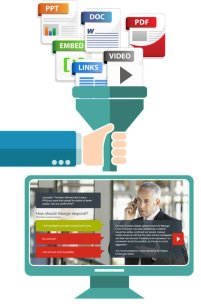This autumn marks 20 years since the founding of Apprix. It should be clear without saying that over the two decades, eLearning has taken quite a leap forward. Jesse Jokinen, Apprix’s founding member, has been with the company throughout its 20-year journey. In this blog post, he talks about the ground covered.

In the early 2000s, around the time Apprix was founded, learning environments mostly consisted of in-house web pages managed by HR departments. The training content available was primarily made up of various PDF and PPT files. As such, the systems did not serve the needs very well, as it was not easy to make sure whether the trainees had actually learned and internalized the knowledge. Moreover, there were no channels in the system allowing the trainees to voice their ideas and questions.
eLearning potential
Even at the time, we acknowledged the potential of eLearning, but felt that the contents were not yet functional. The contents already in use had simply been transferred to the new learning environments and the changed circumstances had not been considered at all. This is why Apprix was established – we wanted to offer better and higher quality eLearning contents, the key to making training interesting, even for otherwise boring subjects.
We went looking for improved attractiveness of contents through gamification. In gamified training courses, inclusiveness was seen as the best aspect, and inclusive training courses have become the core of our business. Inclusiveness can be utilised in all online training, gamified or otherwise.
Solutions also for external target groups
Rather soon, companies also experienced the need for external target group training, such as suppliers, maintenance workers or cleaners staffing their sites. In this connection, user authentication became necessary. Over time, several solutions have been developed at Apprix for serving external target groups (such as reminders of expiring qualifications), which can also be flexibly and easily included under individual training courses. This has become one of Apprix’s strengths – functional solutions for the training of external target groups as well.
Today, it is also very common that data regarding educational performance are transferred between different systems (such as HR, LMS, and access control systems). Various integrations have been carried out for a long time, but over the last few years, the demand for them has grown significantly.

At present, blended learning is on the rise
In addition to integrations, another popular trend in modern online training is combining online and face-to-face training – so-called blended learning. For example, one of our customers has online training courses used for provision of theoretical knowledge. After these, an on-site training day follows, which can focus on practical matters, as all the participants have already acquired basic knowledge on the topic.

There is no single “right” way for online training arrangement; the situation and needs determine the optimal approach in each specific case. However, as a general tip, I would suggest inclusion of the trainee and always making use of practical examples in your training courses.
Towards the future
The prospects for eLearning seem quite promising right now. The situation in the world today has accelerated adoption of various online training courses and their popularity in the corporate environment seems to grow even further. I believe that in the future, organisations will learn to use online training even more diversely and expediently. Here at Apprix, we are always glad to support your organisation, based on our twenty years of experience.
Author

Jesse Jokinen
Managing Partner
Apprix Oy
tel. +358 40 501 9150
jesse.jokinen (a) apprix.fi
